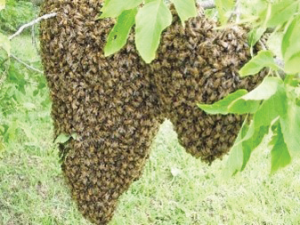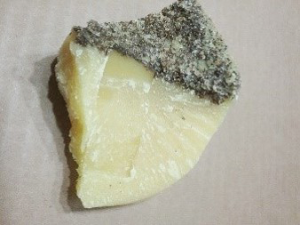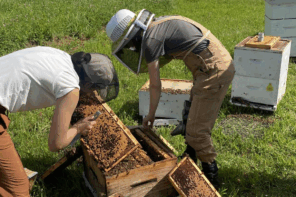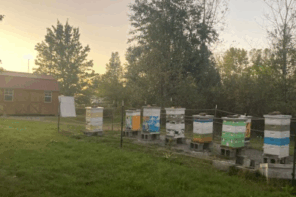By: Ed Simon
The three parts of this collection are subsets of the 263 hints, definitions and informational tidbits gathered in over twenty years of beekeeping. I hope they are helpful.
Selling Honey – Let the bees draw customers in.
When selling honey at an event, take along a portable observation hive. It’s best without a queen, but with capped brood. The lure of bees is a direct eye catcher by kids and their parents who want their kids to experience something they will probably never be able to see anywhere else. There is always the additional possibility you can give the customers a unique experience of watching a worker bee chew her way out of a cell. Once you have delivered your bee spiel, the parents will buy something 60% of the time.
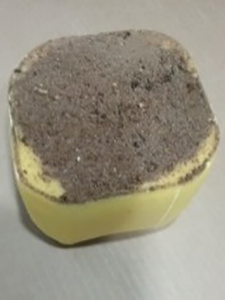 Slumgum
Slumgum
Slumgum is the residue of the beeswax rendering process. When the beeswax from brood comb is rendered to produce clean wax, it leaves behind the pupa casings, skins shed by molting larvae, excrement from larvae, wax moth cocoons and other residual debris included in the original material.
Skunks – They will find a good meal.
Carpet tack strips nailed to the bottom board will stop most skunks. Face the sharp tacks toward the opening.
Smoker – Lighting.
Use a propane or MAP torch to start your smoker. This is probably the easiest way to start a smoker. Get a torch that has a self-starting trigger. It will ignite when you squeeze the trigger and extinguish when the trigger is released.
Smoker – Embers, use grass as a filter.
After your smoker is lit, stuff the chimney with green grass or weeds. This filters the embers from the smoke and at the same time cools it a little bit.
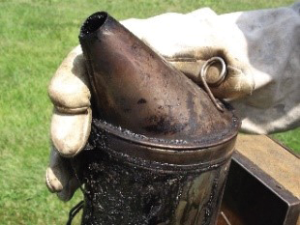 Smoker – Opening.
Smoker – Opening.
After your smoker is lit, you need to add more fuel and it is hot. If you cannot open it by pulling the top tab, then place your thumb under the tab and encircle the top with your fingers. Gloves are required for this operation.
Note: Emptying the smoker for storage and leaving the top open is recommended. Once the creosote cools it is exceedingly difficult to get the top open the next time you want to use it.
Smoker – Cleaning
Your lid never goes on or opens easily due to soot and creosote buildup. Remove the bottom grate and clean. Don’t forget the holes in the bottom grate.
Burn it out – use a MAP or propane torch to start the residual creosote on fire. Then use a scraper or screwdriver to chip the rest away. After cleaning the big chunks out of the smoker, use a wire brush on an electric drill to remove the remaining soot and creosote.
You’ll probably never get it completely clean but, at least you can close the top.
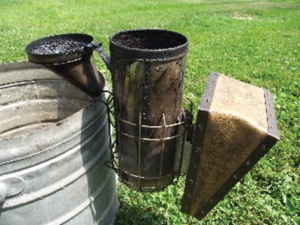 Smoker – Extinguishing.
Smoker – Extinguishing.
Save fuel by smothering the fire when you are finished. Putting a cork in it is one way. Another way is to lay the smoker on its side. The air flow will then be above the fuel and not through the fuel. Make sure you place the smoker on something non-combustible. Laying the smoker on its side was described to me by the U of MN bee squad member during a queen rearing class.
Note: Emptying the smoker and leaving the top open is recommended. Once the creosote cools it is exceedingly difficult to get the top open the next time you want to use it.
Sororicide – When a sibling kills their sister.
Usually, the first queen emerging from her cell locates and kills her sister rivals. If she can locate a rival queen cell, she will open a hole in the side of the cell and kill her before she can emerge.
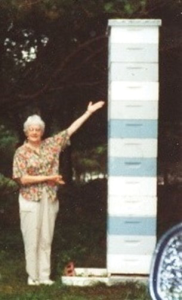 Super Stacking – Seven feet of problems.
Super Stacking – Seven feet of problems.
Don’t do this even though it is tempting for bragging purposes.
At some height, a stack of honey supers can become dangerous. First is the possibility of the complete hive tipping over. Second is the effort required to remove the supers when pulling honey. This hive needed the bed of a pickup and a ladder to remove the top three supers. Propolis added to the problem. In addition to the two-hundred forty pounds of honey this hive produced, it also produced a lot of awfully bad words. When confronted with this situation, you can always move some of the supers to a less energetic hive to wait for extraction.
Note: This picture is of Sister Alice, a Franciscan nun who is 5’ 2” tall. The hive produced 240 lbs. of honey for her.
Swarms – It will happen – be prepared!
Be ready. Have an extra brood box or a nuc available to store the swarm. A cardboard box will do in a pinch. But it helps to have prepared a site and brood box to house the swarm. It doesn’t hurt to have that extra hive leveled and ready to go. Who knows, a swarm may take up residency without any help from you.
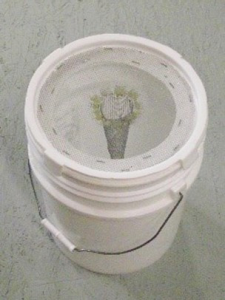 Swarms – Use a funneled pail lid.
Swarms – Use a funneled pail lid.
Build a five-gallon pail with an ⅛ inch hardware cloth top. In the top, add a six-inch funnel. Place the swarm in the pail (hopefully including the queen) and put the top the pail. If you have the queen, the swarm will enter the pail through the funnel.
Swarms – Some swarms abscond.
Reduce the likelihood of having a newly captured swarm absconding by adding a frame with brood to the receiving hive.
Swarms – Did you catch the queen?
After hiving a swarm, you can usually tell if you have captured the queen. Bees outside of the target hive will be migrating toward the hive entrance. At the entrance, you can often see bees “scenting”. They have their butts in the air and may be moving their wings. They are releasing a homing pheromone. It is a signal to the remaining bees that the colony is here, and the queen is in residence.
Syrup – What proportions?
In the Fall, feed 2:1, sugar to water syrup. In the Spring, feed 1:1 sugar to water syrup. The chart below shows the resulting volume when the two are completely mixed and their relative costs.
Temperature Requirements – Thermometers get sticky.
One handy tool I have in my toolbox is an infrared thermometer with a laser. It will allow you to take the temperature of honey, wax or anything else without having to clean it afterwards. To take a temperature, you just aim it and pull the trigger. Three seconds later the temperature is displayed on a screen. No mess, no fuss.
Top Feeder – Bees can get into the syrup chamber.
When a top feeder is empty, there is a possibility that the bees can enter the syrup chamber under the hardware cloth or screen. To minimize or eliminate this problem, seal the screen to the feeder with silicone seal.
Veritable Honey
Honey that was collected by the bees during a blooming of a specific tree or flower. It has a high percentage of a single nectar source.
Washboarding – Obsessive behavior?
When bees gather on the landing board and rock back and forth. As of now, there is no purpose or reason for this behavior.
Wax Cleanup
Wax is almost impossible to remove completely from cloth. Use a paper towel and place it between an iron and your clothes with wax on it. Press the cloth through the paper towel. The towel will absorb the wax when it has melted. It may take a couple of passes to remove most of the wax.
Wax Cleanup
A heat gun and cheap paper towels will clean up the sticky wax. First, remove as much wax as you can with a scraper. Then, warm the wax a little bit with the heat gun. Use the scraper to remove more wax once it is loosened. As a final pass, melt all the remaining wax with the heat gun and wipe it with a clean paper towel.
Wax Facts – Basic beeswax information.
Beeswax melts between 143° and 151°F (62-66°C).
The flashpoint is 490°-525°F (254-274°C).
This is the temperature at which beeswax can flare up and burn fiercely.
The boiling point of water is 212°F (100°C).
Because of the difference in the water boiling point and the wax melting point, wax can be liquified in hot water. When water is available, the evaporation of water will limit the wax temperature to 212°F (100°C). Once the water has boiled off or evaporated, the wax temperature can rise and eventually vaporize and possibly catch on fire.
Because the specific gravity of wax and water are different (wax is lighter than water), when allowed to settle, a melted wax/water mixture will separate. The wax will float on the water. Most impurities usually, although not always, are trapped in a layer between the two. Once the wax solidifies, it can be removed as a large solid cake.
Wax Processing Preparation – Too much honey.
Honey mixed in with the wax you are going to process is a sticky problem. Remove most of the honey before processing it by rinsing it. Place it in a five-gallon pail and add warm water. Mix it around and then drain it before melting it. You won’t eliminate all the honey, but it will help.
| Sugar Syrup | |||||||||||
|---|---|---|---|---|---|---|---|---|---|---|---|
| 1:1 – Light Syrup | 2:1 – Heavy Syrup | Light | Heavy | ||||||||
| Sugar (lbs.) | Water (pints) | Resulting Volume (pints) | Sugar (lbs.) | Water (pints) | Resulting Volume (pints) | Sugar cost per pound | 0.60 | ||||
| 10.0 | 12 | 16 | 10.0 | 6 | 11.0 | Syrup cost per pint | 0.34 | 0.54 | |||
| 5.0 | 6 | 8 | 5.0 | 3 | 5.5 | Syrup cost per gallon | 2.99 | 4.34 | |||
| 4.0 | 5 | 6.5 | 4.0 | 2.4 | 4.4 | ||||||
Wax Processing – Breaking cakes of wax.
If you have cakes of wax that are too large to fit into your wax melter, place them in a cardboard box and use a hammer and chisel to split them. The cardboard box stops the wax chips from flying all over your workroom.
Wax Processing – Use water to separate crud from wax.
When melting raw cruddy wax, add water while melting it. Water and wax do not mix. When the wax is poured into a container the water/wax mixture will separate into layers. Water will be the bottom layer with a mixture of impurities (crud) above it and then a layer of wax on top. The slower the mixture cools, the longer the crud has time to separate from the wax.
| 55 – 60 lbs. | Full filled 9-frame medium super |
| 12 – 18 lbs. | Wet 9-frame super (after extraction) |
| 90 – 100 lbs. | Large 10-frame brood box |
Weight of Honey – A quick easy way to estimate the weight of honey.
Honey weighs about 1.5 times more than the same volume of water.
A gallon of water weighs about eight pounds. A gallon of honey weighs about twelve pounds.
A good example of this is the standard honey bear. It holds eight ounces of honey or water by volume. But it is considered a twelve-ounce honey bear (by weight).
Weight of Hive Bodies (above chart)
A generalized weight for standard bee equipment.
A complete list of all the entries collected is published in Build Beekeeping Equipment. It is available through www.LULU.com. It contains a full set of unabridged entries in a chapter called “What Your Mentor Forgot to Tell You.” Under the LULU sales section, search for “Beekeeping” to find this publication.







